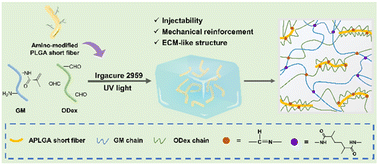In situ forming double-crosslinked hydrogels with highly dispersed short fibers for the treatment of irregular wounds†
Abstract
In situ forming injectable hydrogels hold great potential for the treatment of irregular wounds. However, their practical applications were hindered by long gelation time, poor mechanical performance, and a lack of a natural extracellular matrix structure. Herein, amino-modified electrospun poly(lactic-co-glycolic acid) (APLGA) short fibers with uniform distribution were introduced into gelatin methacrylate/oxidized dextran (GM/ODex) hydrogels. In comparison with the fiber aggregation structure in the PLGA fiber-incorporated hydrogels, the hydrogels with APLGA fibers possessed a uniform porous structure. The highly dispersed APLGA short fibers accelerated the sol–gel phase transition of the hydrogel due to the formation of dynamic Schiff-base bonds between the fibers and hydrogels. Furthermore, in combination with UV-assisted crosslinking, a rapid gelation time of 90 s was achieved for the double-crosslinked hydrogels. The addition of APLGA short fibers as fillers and the formation of the double-crosslinking network enhanced the mechanical performance of the hydrogels. Furthermore, the fiber–hydrogel composites exhibited favorable injectability, excellent biocompatibility, and improved cell infiltration. In vivo assessment indicated that the GM/ODex-APLGA hydrogels successfully filled the full-thickness defects and improved wound healing. This work demonstrates a promising solution for the treatment of irregular wounds.

- This article is part of the themed collection: Biomaterials Science Emerging Investigator Series


 Please wait while we load your content...
Please wait while we load your content...